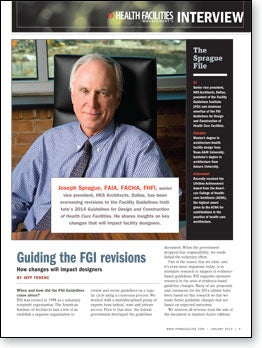Guiding the FGI revisions
 Joseph Sprague, FAIA, FACHA, FHFI, senior vice president, HKS Architects, Dallas, has been overseeing revisions to the Facility Guidelines Institute's 2014 Guidelines for Design and Construction of Health Care Facilities. He shares insights on key changes that will impact facility designers.
Joseph Sprague, FAIA, FACHA, FHFI, senior vice president, HKS Architects, Dallas, has been overseeing revisions to the Facility Guidelines Institute's 2014 Guidelines for Design and Construction of Health Care Facilities. He shares insights on key changes that will impact facility designers.
When and how did the FGI Guidelines come about?
FGI was created in 1998 as a voluntary nonprofit organization. The American Institute of Architects had a few of us establish a separate organization to review and revise guidelines on a regular cycle using a consensus process. We worked with a multidisciplined group of experts from federal, state and private sectors. Prior to that time, the federal government developed the guidelines document. When the government dropped that responsibility, we established the voluntary effort.
Part of the reason that we exist, and it's even more important today, is to stimulate research in support of evidence-based guidelines. FGI supports extensive research in the area of evidence-based guideline changes. Many of our proposals and comments for the 2014 edition have been based on this research so that we make better guideline changes that are based on expected outcomes.
We reinvest all revenue from the sale of the document to improve future editions.
Who is involved in making proposed revisions to the Guidelines?
The Health Guidelines Revision Committee (HGRC) is a multidisciplinary consensus body. It includes more than 120 clinicians, administrators, architects, engineers and representatives from authorities having jurisdiction and is convened to revise and update the Guidelines for Design and Construction of Health Care Facilities. As a group, HGRC members are experts on the many issues addressed in the Guidelines.
The participation of individuals with such a wide range of expertise helps make the document one that reflects a variety of clinical, administrative, engineering and design concerns that are based on interdisciplinary consensus. This consensus is developed through a public process that includes three meetings of the full HGRC, generally held over the four-year period.
How do the proposed guidelines address patient safety and infection control?
Response by the public on proposals for infection control risk-assessment strategies was very popular. Infection control and risk mitigation have always been in the minds of the leadership, but it took the form of a specific assessment in the infection control risk-assessment consideration.
We moved from that to such other patient safety risk-assessment areas as patient handling and movement assessment, which involves movement within the facility and the environment. We continue to use these assessment strategies in looking at how infection control and all the issues related to health care-associated infections can be managed better through the guidelines governing the built environment.
Specific areas that are under consideration for revision are looking at changes to medication zones and the delivery of medication therapy. We also will consider location and access to hand-washing stations.
What prompted the proposed changes to the emergency department requirements?
I believe most would agree the emergency department (ED) has become the front door to the hospital in many ways. We made some substantial changes to the 2010 edition that governed different aspects of emergency care. There were numerous comments and proposals to change that
chapter to address this issue.
EDs still seem to be a very prevalent facility type within health systems and networks, as they feed the system into the acute care environment and even the secondary and tertiary environments. We will look at proposals to redefine emergency services and at the reception and triage areas to improve access and observation.
What design guidance will there be for ambulatory surgical centers, physician offices and retail spaces?
What we're seeing is that anticipation of health care reform measures is driving hospital and physician alignment and creating the need for additional ambulatory care outpatient services as feeders in the system to the entire network. We're trying to see if there's a better way to manage the tremendous demand that reform will bring in terms of increased patient volumes.
There are proposals to consider adding more outpatient diagnostic and treatment services, including angiography, PET/CT and outpatient surgical procedures with pharmacy and laboratory support. We also will look at outpatient operating room design classification change.
Will the next edition of the Guidelines lean more toward designing for best practice or a return to minimum standards?
This is an ongoing debate that we have in our Health Guidelines Revision Committee. There are a lot of folks who want the Guidelines to be a best practice. The Joint Commission talks about optimal achievable standards.
The Guidelines are a minimum standard, but certainly best practice is always brought up. What we have done is put some of the best practice ideas in the appendix. Those people who are reading the main text, which has prescriptive or performance guidelines, can test the best practices listed in the appendix.
I think we're going to improve by incorporating and being inclusive of new ideas and new ways of designing a better built environment. But in the long run, it's very likely to continue to be a minimum standard document.
When does the vote take place on the final document?
In the summer we will send out the final document for a vote by letter ballot. We hope to have the 2014 Guidelines available at the beginning of 2014 if not earlier. That's our goal and we're set to achieve it.
Jeff Ferenc is senior editor for Health Facilities Management.
| Sidebar - The Sprague File |
| CV: Senior vice president, HKS Architects, Dallas; president of the Facility Guidelines Institute (FGI) and chairman emeritus of the FGI Guidelines for Design and Construction of Health Care Facilities. Education: Master's degree in architecture-health facility design from Texas A&M University; bachelor's degree in architecture from Auburn University. Achievement: Recently received the Lifetime Achievement Award from the American College of Healthcare Architects (ACHA), the highest award given by the ACHA for contributions in the practice of health care architecture. |
| Sidebar - What are the FGI Guidelines? |
| The FGI Guidelines recommend minimum program, space and equipment needs for clinical and support areas of hospitals, ambulatory care facilities and more. They address minimum engineering design criteria for plumbing, electrical and HVAC systems, and serve as a code or a reference standard for several federal agencies, 42 states and the Joint Commission. |




